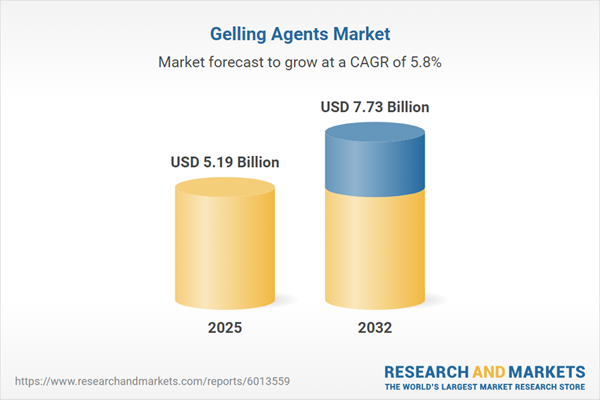Speak directly to the analyst to clarify any post sales queries you may have.
The gelling agents market is rapidly transforming, requiring actionable strategies to address changing consumer preferences, regulatory shifts, and demands for sustainable operations. Executive decision-makers must respond with agility to these industry developments to maintain competitiveness and support long-term business resilience.
Market Snapshot: Gelling Agents Market Overview
The global gelling agents market is set for steady expansion from 2024 to 2032, with a projected compound annual growth rate of 5.84%. Demand spans diverse sectors, from food and pharmaceuticals to heavy industry, propelled by an increased focus on natural, multifunctional polymers and clean-label solutions. Leading companies in this space are enhancing compliance frameworks and innovating product development to align with more stringent customer and regulatory demands. Senior leaders are implementing digital transformation initiatives and adaptive procurement practices to ensure competitiveness and flexibility as the market landscape evolves. Strong regional dynamics—particularly in both established and rapidly developing markets—are shaping investment, operational, and supply chain strategies.
Scope & Segmentation of the Gelling Agents Market
- Applications: Gelling agents are integral across sectors such as baked goods, dairy, confectionery, sauces, beverages, dressings, oil and gas extraction, textiles, well cementing, specialty coatings, paper, and personal care, including skin, hair, and oral care. Their critical role in pharmaceutical formulations and drug delivery systems highlights their value in both consumer and industrial verticals.
- Type: Natural variants like agar-agar, guar gum, pectin, carrageenan, and xanthan gum lead the shift toward clean-label, sustainable options. Semi-synthetic forms, including modified cellulose and starch, deliver tailored performance advantages, while synthetic types such as carbomer, cellulose derivatives, and polyacrylamide provide precise functional control, especially in medical and industrial settings.
- Source: Main sources include animal and plant-derived ingredients, especially seaweed-based options like agar-agar, alginates, and carrageenan, alongside seed extracts such as pectin and guar gum. Microbial fermentation produces gellan gum, xanthan gum, and curdlan, bolstering supply chain security.
- Distribution Channels: Direct supplier relationships underpin reliable partnerships, while distributors and wholesalers extend market reach globally. Digital procurement platforms enable more efficient sourcing, streamlined inventory, and greater operational agility, particularly beneficial in complex manufacturing environments.
- Grade: Options range from food-grade and pharmaceutical-grade to industrial-grade gelling agents, aligning with variable regulatory requirements and production standards across industries.
- Geography: The market operates robustly in established economies—including the United States, Germany, and Japan—and sees rising demand in emerging regions such as Brazil, China, and India. This geographical reach supports locally tailored business strategies to meet region-specific regulatory and consumer needs.
- Key Companies: Prominent suppliers include Cargill, International Flavors & Fragrances, CP Kelco, Ingredion, Ashland Global Specialty, Kerry Group, Tate & Lyle, Darling Ingredients, DuPont, and BASF. These organizations collectively ensure stable product availability and consistent global supply for enterprise customers.
Key Takeaways: Strategic Insights for Senior Decision-Makers
- Ingredient transparency now drives sourcing and product innovation, requiring alignment with evolving clean-label mandates and high quality benchmarks.
- Sustainability initiatives are accelerating the transition to plant-based and microbial gelling agents, reinforcing resilient, adaptive supply networks worldwide.
- Digitalization enables predictive management of the gelling agents supply chain, improving responsiveness to raw material variability and international demand fluctuations.
- Collaboration with biotechnology and research partners fosters development of customized gelling solutions that meet complex functionality and regulatory challenges.
- Diversified procurement strategies are essential for reducing exposure to risks from logistics and changing global policies, promoting improved agility and risk mitigation.
Tariff Impact: Navigating Trade Shifts
Recent changes in United States tariff regulations are prompting organizations to expand domestic manufacturing and critically assess global procurement approaches. Multipronged sourcing agreements and flexible supplier partnerships are enabling companies to manage risk and preserve supply continuity as policy landscapes shift.
Methodology & Data Sources
This report has been developed from a comprehensive blend of primary research, secondary resource analysis, and expert interviews. Regulatory and patent reviews form the analytical foundation, while direct engagement with stakeholders in formulation, procurement, and quality management ensures targeted insights for strategic implementation.
Why This Report Matters
- Prepares senior executives with strategies for strengthening supply chain resilience and ensuring regulatory compliance in dynamic market and legislative environments.
- Supports the identification of high-value business segments and emerging technologies, helping prioritize investments and research endeavors.
- Provides actionable intelligence for procurement and R&D leaders to manage risks and drive effective product introduction initiatives.
Conclusion
As the gelling agents market evolves, organizations that embed sustainability into sourcing and leverage digital tools across their value chains are positioned to sustain operational stability and achieve sustained growth.
Additional Product Information:
- Purchase of this report includes 1 year online access with quarterly updates.
- This report can be updated on request. Please contact our Customer Experience team using the Ask a Question widget on our website.
Table of Contents
3. Executive Summary
4. Market Overview
7. Cumulative Impact of Artificial Intelligence 2025
Companies Mentioned
The companies profiled in this Gelling Agents market report include:- Cargill, Incorporated
- International Flavors & Fragrances Inc.
- CP Kelco US, Inc.
- Ingredion Incorporated
- Ashland Global Specialty Ingredients, Inc.
- Kerry Group PLC
- Tate & Lyle PLC
- Darling Ingredients Inc.
- DuPont de Nemours, Inc.
- BASF SE
Table Information
| Report Attribute | Details |
|---|---|
| No. of Pages | 184 |
| Published | November 2025 |
| Forecast Period | 2025 - 2032 |
| Estimated Market Value ( USD | $ 5.19 Billion |
| Forecasted Market Value ( USD | $ 7.73 Billion |
| Compound Annual Growth Rate | 5.8% |
| Regions Covered | Global |
| No. of Companies Mentioned | 11 |









